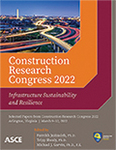Integrating Social Equity and Vulnerability with Infrastructure Resilience Assessment
Publication: Construction Research Congress 2022
ABSTRACT
Resilient infrastructure, which better withstands, adapts, and recovers from disasters, plays an important role in mitigating the impacts of natural hazards to the communities. However, disparities exist in infrastructure damage and recovery across communities with different socioeconomic backgrounds. Socially vulnerable communities experience more severe infrastructure damage and require longer time to repair and resume infrastructure services. Thus, there is a need to systematically integrate social equity with infrastructure resilience assessment. To address this need, this paper proposes a social welfare-based infrastructure resilience assessment framework that accounts for (1) the unequal distribution of infrastructure damage and recovery across communities with different socioeconomic statuses and (2) the potentially higher infrastructure damage and longer recovery time in socially vulnerable communities. The proposed model can facilitate equitable resilience in infrastructure planning and recovery by allowing for a better understanding and assessment on how infrastructure in different communities is equally or unequally affected by disasters.
Get full access to this article
View all available purchase options and get full access to this chapter.
REFERENCES
AJMC (The American Journal of Managed Care). 2006. “Vulnerable Populations: Who Are They?” Last accessed on Jan 30, 2021. <https://cdn.sanity.io/files/0vv8moc6/ajmc/7156d97747bada738caf6bb3e702169373491cc8.pdf>.
Arrow, K. J. 1963. Social Choice and Individual Values. Vol 12, Yale University Press, New Haven, CT.
Atkinson, A., and Brandolini, A. 2010. “On Analyzing the World Distribution of Income.” World Bank Economic Review, 24(1), 1–37.
Balaei, B., Wilkinson, S., Potangaroa, R., Hassani, N., and Alavi-Shoshtari, M. 2018. “Developing a framework for measuring water supply resilience.” Natural Hazards Review, 19(4), 04018013.
Bruneau, M., Chang, S. E., Eguchi, R. T., Lee, G. C., O’Rourke, T. D., Reinhorn, A. M., Shinozuka, M., Tierney, K., Wallace, W. A., and Von Winterfeldt, D. 2003. “A framework to quantitatively assess and enhance the seismic resilience of communities.” Earthquake Spectra, 19(4), 733–752.
Cimellaro, G. P., Reinhorn, A. M., and Bruneau, M. 2010. “Framework for analytical quantification of disaster resilience.” Engineering Structures, 32(11), 3639–3649.
Cutter, S. L., Boruff, B. J., and Shirley, W. L. 2003. “Social Vulnerability to Environmental Hazards.” Social Science Quarterly, 84(2), 242–261.
Clarke, M., and Islam, S. M. 2003. “Measuring social welfare: application of social choice theory.” Journal of Socio-Economics, 32(1), 1–15.
Flanagan, B. E., Gregory, E. W., Hallisey, E. J., Heitgerd, J. L., and Lewis, B. 2011. “A Social Vulnerability Index for Disaster Management.” Journal of Homeland Security and Emergency Management, 8(1), 1–24.
Godschalk, D. R. 2003. “Urban hazard mitigation: creating resilient cities.” Natural Hazards Review, 4(3), 136–143.
Harsanyi, J. C. 1955. “Cardinal welfare, individualistic ethics, and interpersonal comparisons of utility.” Journal of Political Economy, 63(4), 309–321.
Mao, Q., and Li, N. 2018. “Assessment of the impact of interdependencies on the resilience of networked critical infrastructure systems.” Natural Hazards, 93(1), 315–337.
Makropoulos, C., Nikolopoulos, D., Palmen, L., Kools, S., Segrave, A., Vries, D., Koop, S., Van Alphen, H. J., Vonk, E., Van Thienen, P., Rozos, E., and Medema G. 2018. “A resilience assessment method for urban water systems.” Urban Water Journal, 15(4), 316–328.
Masozera, M., Bailey, M., and Kerchner, C. 2007. “Distribution of impacts of natural disasters across income groups: A case study of New Orleans.” Ecological Economics, 63(2-3), 299–306.
Mostafa, M. A., and El-Gohary, N. M. 2014. “Stakeholder-sensitive social welfare–oriented benefit analysis for sustainable infrastructure project development.” Journal of Construction Engineering and Management, 140(9), 04014038.
Nexus. 2017. “Hurricane Harvey hit low-income communities hardest” Last accessed Feb 05, 2020. <https://archive.thinkprogress.org/hurricane-harvey-hit-low-income-communities-hardest-d13506b7e60/>.
Rawls, J. 1971. A Theory of Justice. Harvard University Press, Cambridge, MA.
Rehak, D., Senovsky, P., Hromada, M., and Lovecek, T. 2019. “Complex approach to assessing resilience of critical infrastructure elements.” International Journal of Critical Infrastructure Protection, 25, 125–138.
Schneider, M., and Kim, B. C. 2020. “The utilitarian–maximin social welfare function and anomalies in social choice.” Southern Economic Journal, 87(2), 629–646.
Sen, A. 1997. On Economic Inequality. Oxford University Press, Oxford, UK.
Yang, Y., Tang, W., Liu, Y., Xin, Y., and Wu, Q. 2018. “Quantitative resilience assessment for power transmission systems under typhoon weather.” IEEE Access, 6, 40747–40756.
Zhang, L., and Sanake, S. 2020. “Social Welfare-Based Human Comfort Aggregation Model to Facilitate Healthy and Comfortable Indoor Environments.” Journal of Architectural Engineering, 26(3), 04020027.
Information & Authors
Information
Published In
History
Published online: Mar 7, 2022
Authors
Metrics & Citations
Metrics
Citations
Download citation
If you have the appropriate software installed, you can download article citation data to the citation manager of your choice. Simply select your manager software from the list below and click Download.
